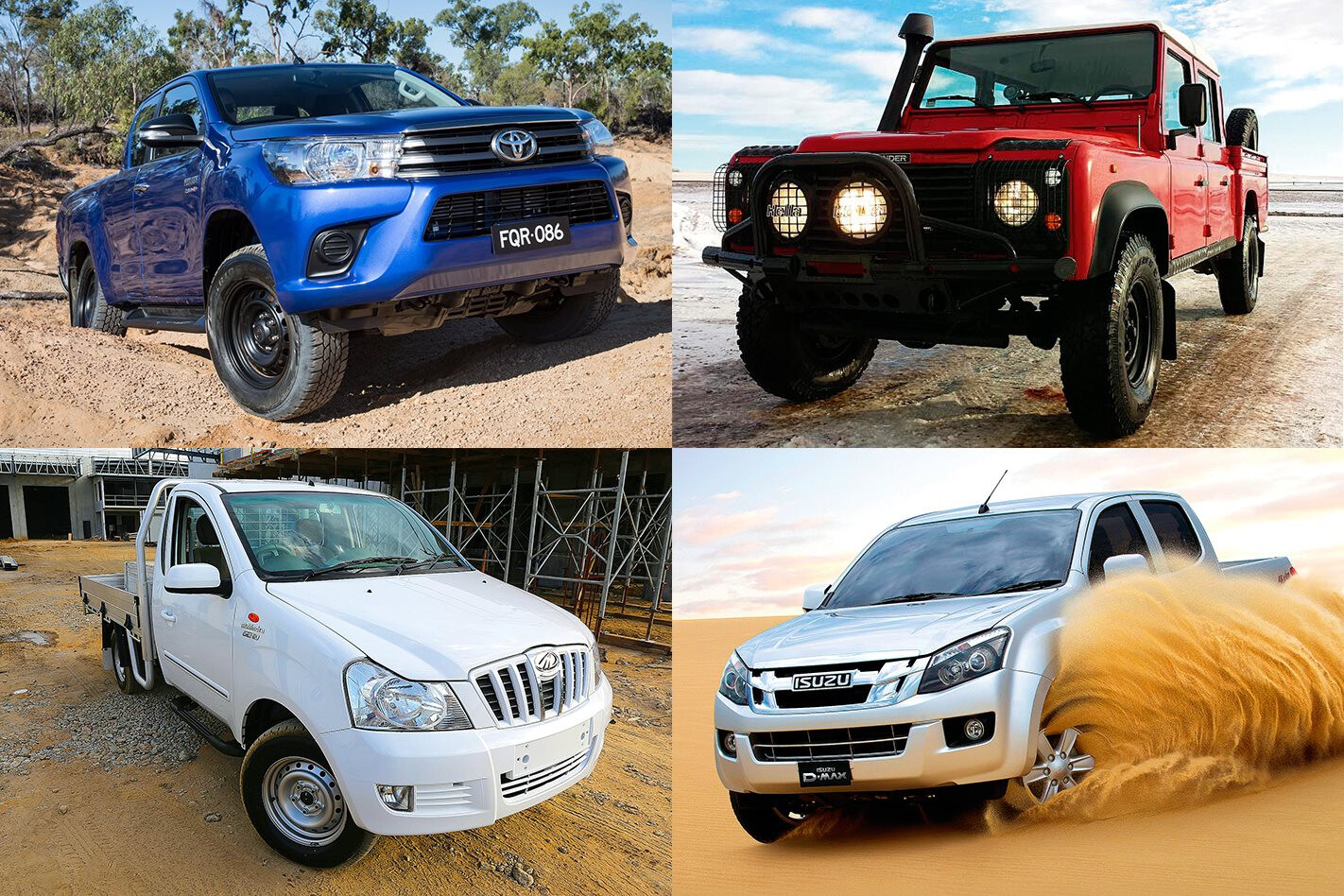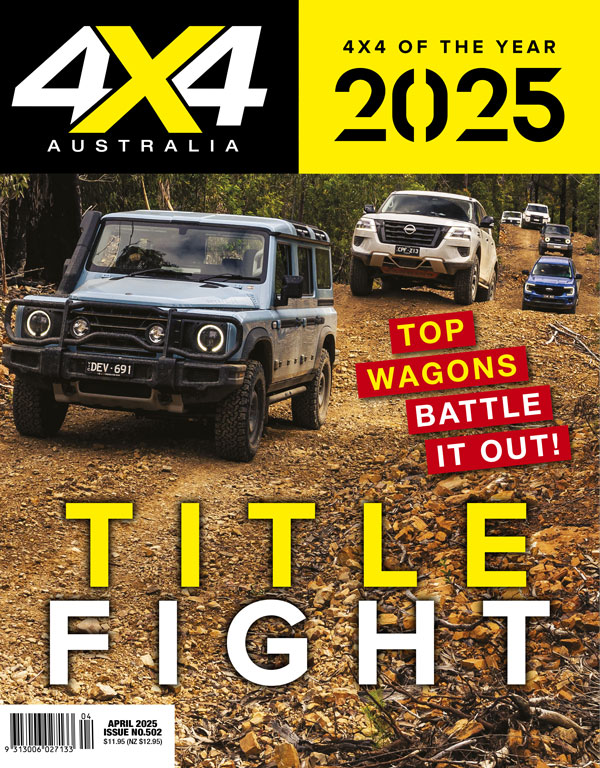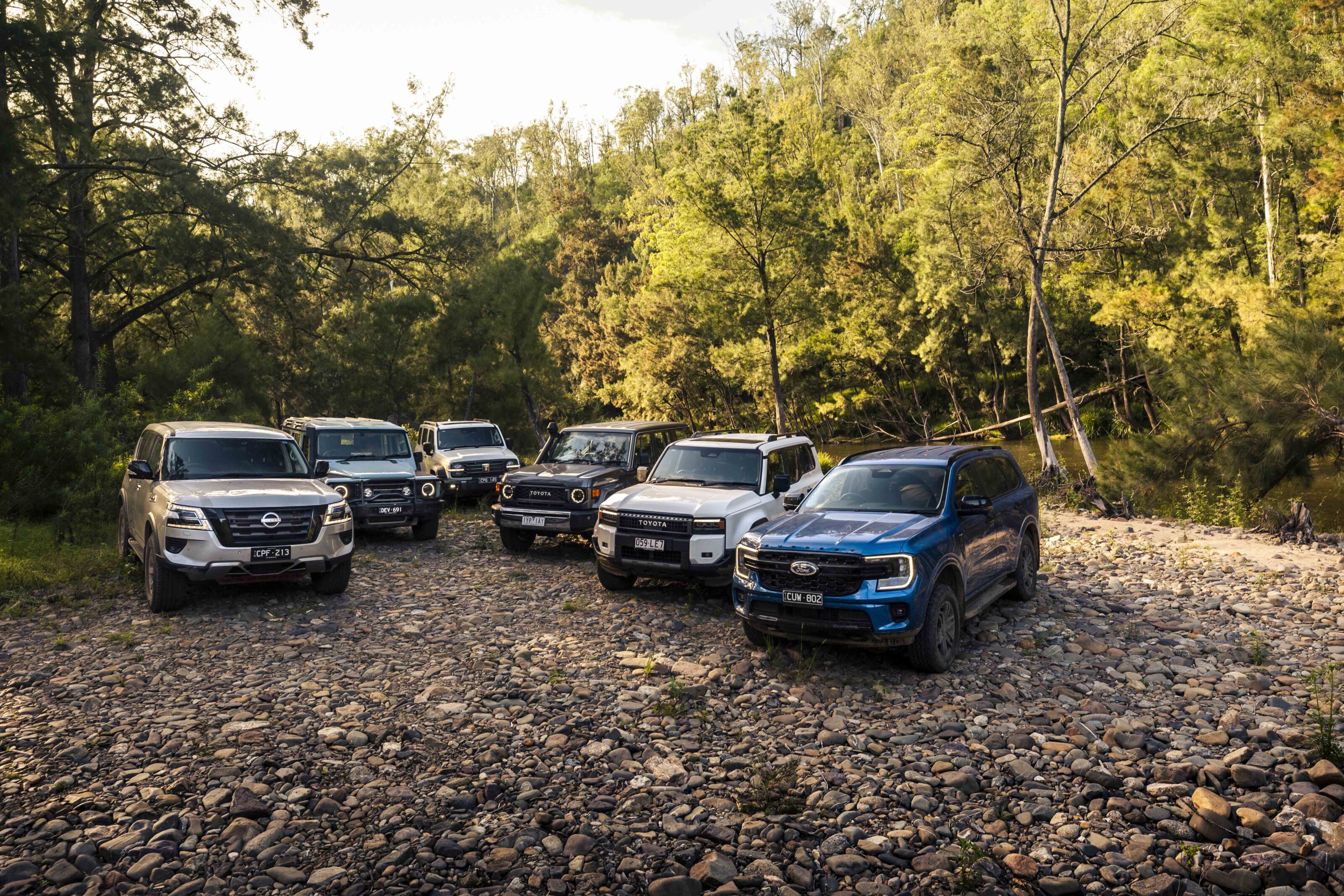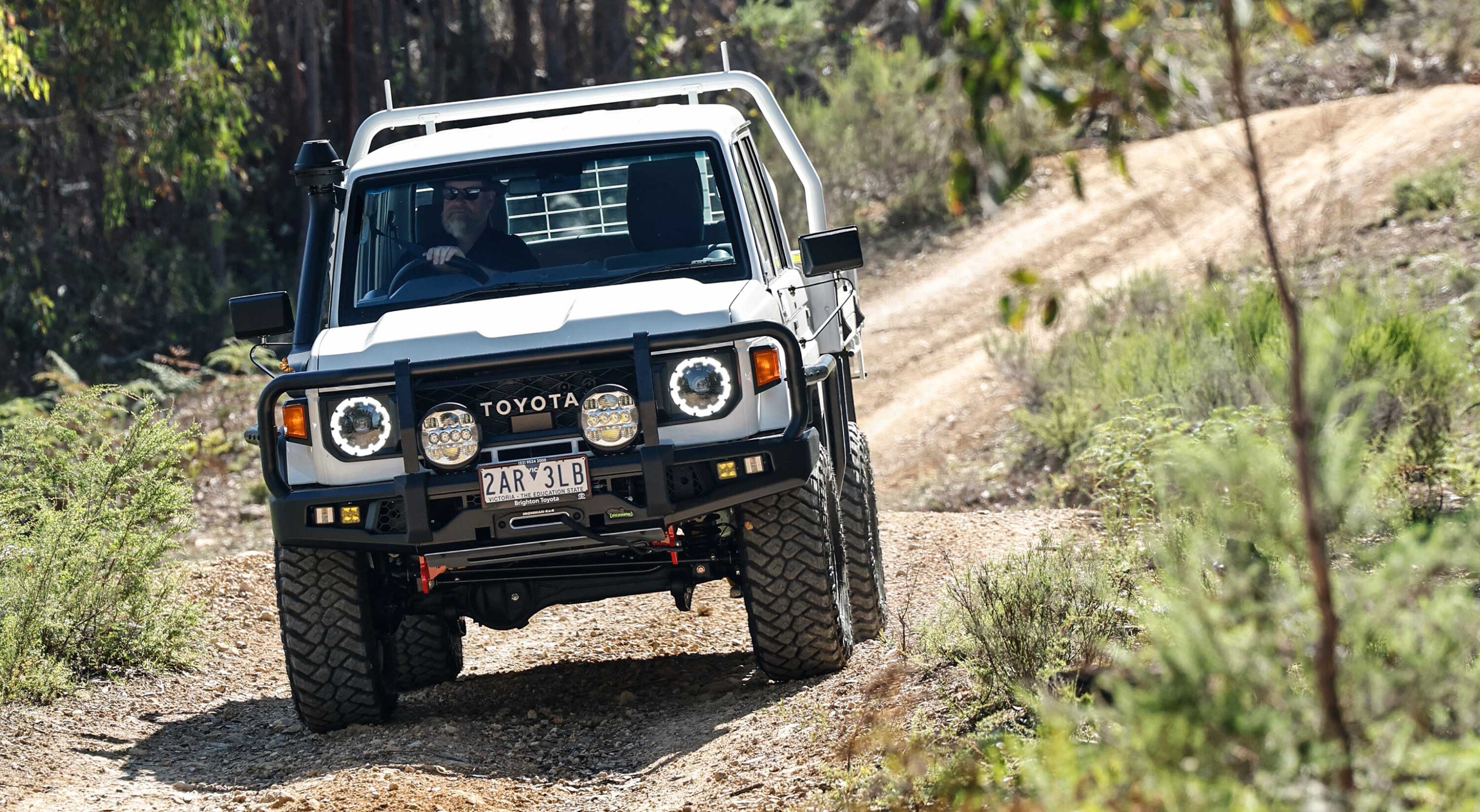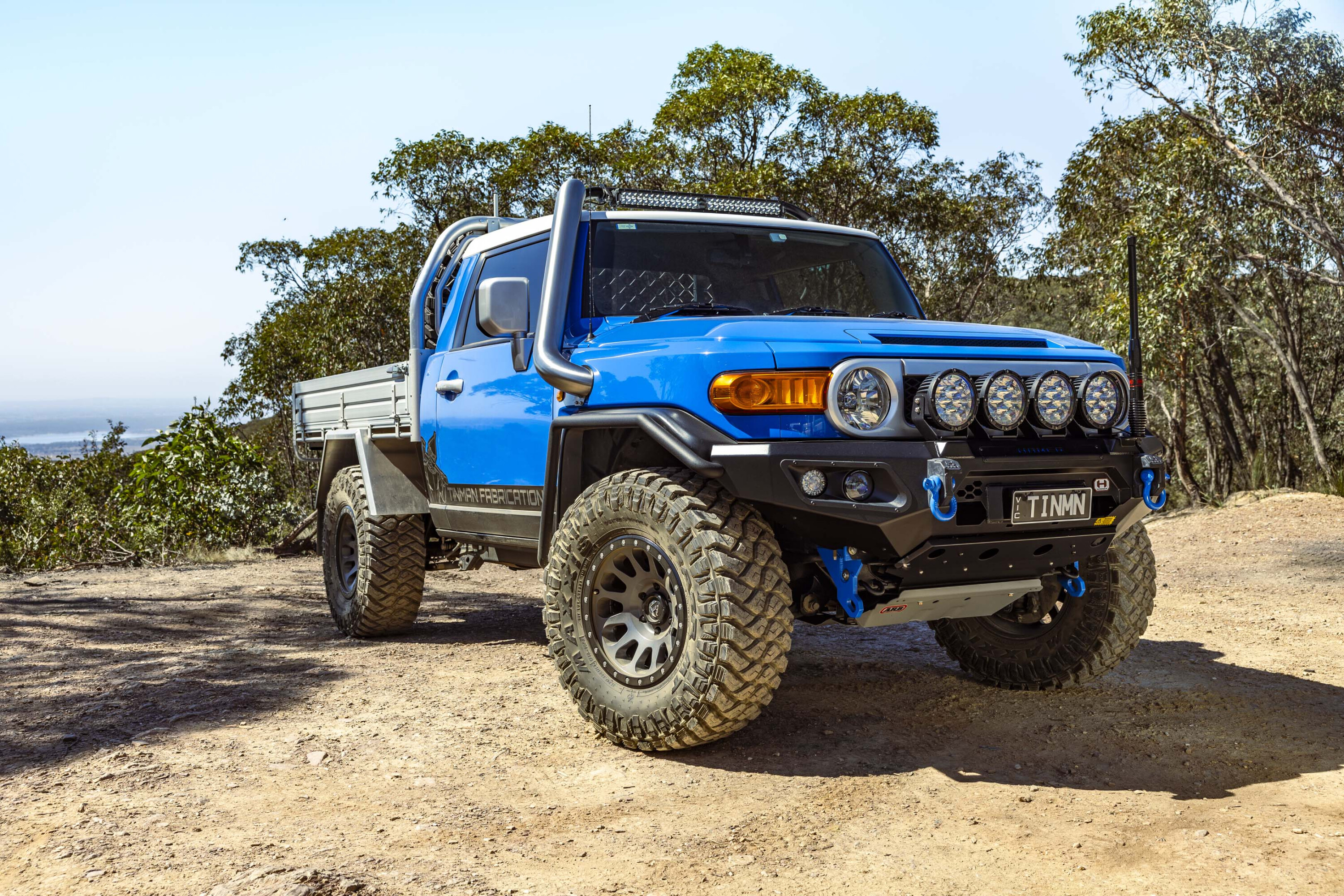Sales of 4×4 utes are booming. Australia’s most popular ute, the Toyota HiLux, is often Australia’s most popular new vehicle, outselling even the most popular passenger car, the Toyota Corolla.
Nearly 80 per cent of all ute sales are 4x4s – the rest are two-wheel drive versions of those 4x4s, joined by the enduringly popular Aussie Ford Falcon and Holden Commodore utes.
We’ve rounded up 17 4×4 utes that range in price from $22,000 to $66,000 (and you still have to pay for a tray and the on-road costs). So it’s safe to say, there should be something here for everyone.
The 17 utes fall into three natural categories: eight mainstream utes; three heavy-duty utes, that are more like light trucks than utes; and seven budget utes.
The mainstream utes are the Ford Ranger, Holden Colorado, Isuzu D-Max, Mazda BT-50, Mitsubishi Triton, Nissan Navara, Toyota HiLux and VW Amarok. Check out our 8-way dual-cab ute comparison when we put these 4×4’s to the test.
The tougher utes include the Land Rover Defender, Nissan Patrol and Toyota LandCruiser 79.
The budget utes represent the emerging Chinese, Korean and Indian vehicle industries. They are the Foton Tunland, JMC Vigus, Mahindra Genio, Mahindra Pik-Up, Ssangyong Actyon and Tata Xenon.
FORD RANGER
Ford’s revamped Ranger is so popular it is giving Toyota’s long-time class-sales champ, the HiLux, a run for its money.
Designed and developed in Australia, the Ranger arrived in late 2011nd in late 2015 it underwent a significant revision designed to improve its functionality, performance, refinement and off-road ability.
Compared to its immediate rivals, the Ranger is a physically big ute powered by a relatively big, torquey and low-revving 3.2-litre five-cylinder diesel engine, which gets the job done without any fuss. The 3.2 can be backed by a six-speed manual with a much improved shift feel thanks to the 2015 update, or a slick six-speed automatic. The Ranger is also offered with a less expensive 2.2-litre four-cylinder diesel in both single- and dual-cab 4x4s.
Regardless of the engine, the Ranger handles and rides well on-road and is as good as or better than all of its immediate rivals off-road, again thanks in part to its 2015 revamp. The Ranger has good working credentials, with a 3500kg tow rating and a class-leading 3200kg GVM. All Ranger variants also have a five-star ANCAP safety rating.
SPECS Engine* 3.2L 5cyl turbo-diesel Max power/torque 147kW/470Nm Gearbox(s) 6M/6A 4×4 system part-time dual-range Kerb weight 1762kg – 2200kg GVM 3200kg Tow rating 3500kg Safety rating 5-star *2.2-litre 4cyl TD in some models.
PRICING Single cab $38,790 – $46,480 Extended cab $43,790 – $54,590 Dual cab $43,290 – $60,090 *4×4 models only; does not include on-road costs.
For: Big, torquey engine; spacious dual-cab. Against: Not as frugal as immediate rivals.
TOYOTA HILUX
The HiLux has been Australia’s most popular ute and 4×4 for a good while now, even if that position is currently under threat from the Ford Ranger.
This eighth-generation HiLux, released in late 2015, is available in 19 4×4 models; 12 of which are dual-cabs, the rest being single- and extended-cab models. Among the mainstream utes, the HiLux is unique in offering a petrol engine as well as diesels; in this case a 4.0-litre V6, which is in two dual-cab models and comes with a six-speed automatic that’s new to this generation HiLux.
Two four-cylinder diesel engines are offered: a 2.4 in the base Workmate models and a 2.8 elsewhere. These two all-new diesel engines are backed by two new six-speed manuals, or a six-speed auto. Both new diesel engines offer more torque than the superseded 3.0-litre diesel.
This new HiLux isn’t any bigger than the last-generation model, but is more refined, can tow more (up to 3500kg) and is far better on- and off-road.
At this stage the HiLux comes in Workmate, SR or SR5 grades, but a new top-spec model above SR5 is on the cards.
SPECS Engine* 2.8L 4cyl turbo-diesel Max power/torque 130kW/420Nm or 450Nm Gearbox(s) 6M/6A 4×4 system part-time Kerb weight 1775kg – 2080kg GVM 3000kg – 3050kg Tow rating 3200kg – 3500kg Safety rating 5-star *2.4L TD and 4.0L petrol V6 also available.
PRICING Single cab $36,990 – $41,490 Extended cab $40,490 – $51,990 Dual cab $43,990 – $57,990 *4×4 models only; does not include on-road costs.
For: Hard to go past. Against: SR models skinny on equipment.
NISSAN NAVARA
The all-new NP300 Navara arrived in 2015, replacing both the previous-generation D40 Navara and the even older (and smaller) D22 Navara, which were sold concurrently. At first, the NP300 was only available as a dual-cab, but single- and extended-cab models arrived later to fill out the range.
In the 4×4 range, all single-cabs and the RX-spec extended- and dual-cabs come with a 2.3-litre turbo-diesel that claims 120kW and 403Nm. King-cabs and dual-cabs in ST and ST-X spec have a more sophisticated bi-turbo engine that claims 140kW and 450Nm. The standard gearbox is the six-speed manual, with a seven-speed automatic available as an option in all cab configurations.
The NP300 is unique among its immediate competitors in offering coil as well as leaf spring rear suspension. Coil springs are fitted to all dual-cabs bar the base spec RX, while all single- and extended-cabs (and, of course, the RX dual-cab) have leaf springs.
The NP300 is smaller than the likes of the Ford Ranger and VW Amarok, but drives well on road, is well-equipped for the money and has five-star safety. More ground clearance would help off-road.
SPECS Engine* 2.3L 4cyl bi-turbo-diesel Max power/torque 140kW/450Nm Gearbox(s) 6M/7A 4×4 system part-time dual-range Kerb weight 1604kg – 1980kg GVM 2910kg Tow rating 3500kg Safety rating 5-star *2.3L 120kW single-turbo in some models
PRICING Single cab $31,990 – $35,490 Extended cab $35,490 – $51,490 Dual cab $38,490 – $54,490 *4×4 models only; does not include on-road costs.
For: Value and equipment. Against: Needs more ground clearance.
HOLDEN COLORADO
The Colorado arrived in 2012 and, unlike the previous-generation Colorado (and all the Holden Rodeo utes over the decades), it’s a General Motors’ product and not a rebadged Isuzu.
The Colorado is currently Australia’s fourth most-popular 4×4 ute and has slowly improved in sales since its launch; perhaps due in part to revisions of spec and equipment.
The Colorado is powered by a 2.8-litre four-cylinder diesel from diesel specialist VM Motori. It claims 147kW and 440Nm with the six-speed manual, or 147kW and 500Nm with the six-speed auto. Surprisingly, it feels more potent with the manual gearbox despite the manual’s way-too-tall final-drive gearing. With the auto, it’s still the class performance leader.
On the downside the engine is noisy and harsh, the cabin feels cheap despite being roomy, and the ride is too firm. The Colorado is nothing special off-road, where it is well behind rivals including the Ford Ranger and Toyota HiLux.
Single- and extended-cab Colorados have a four-star ANCAP safety, while dual-cabs have five-star safety.
SPECS Engine 2.8L 4cyl turbo-diesel Max power/torque 147kW/440Nm/500Nm Gearbox(s) 6M/6A 4×4 system part-time dual-range Kerb weight 1773kg – 2125kg GVM 2950kg – 3150kg Tow rating 3500kg Safety rating 4/5-star
PRICING Single cab $35,990 – $39,190 Extended cab $41,450 – $56,690 Dual cab $43,990 – $57,190 *4×4 models only; does not include on-road costs.
For: Strong engine performance. Against: Lacks polish; feels cheap.
ISUZU D-MAX
Released in 2012 and remaining largely unchanged since then, the Isuzu D-Max shares the basic chassis and body design of the Holden Colorado. But it has its own engine, gearboxes, 4×4 drivetrain, exterior body panels, and interior fit-out and equipment.
The 3.0-litre engine is Isuzu’s own and has been around in one form or another for the last 10 years. In its previous guise, it powered the last-generation Isuzu D-Max and Holden Colorado (and the last of the Rodeo-badged Holden utes, too).
On the road it offers easy but modest performance, combined with decent refinement and good economy. All but the base-model single-cab is offered with a well-proven Aisin five-speed auto – also used extensively by Toyota in various 4x4s up until last year. A five-speed manual is standard across the range.
The D-Max lacks the on- and off-road polish of its more sophisticated rivals, but is priced well and comes up well as an ownership proposition.
Dual-cab models have a five-star ANCAP safety rating, while single- and extended-cabs have a four-star rating.
SPECS Engine 3.0L 4cyl turbo-diesel Max power/torque 130kW/380Nm Gearbox(s) 5M/5A 4×4 system part-time dual-range Kerb weigh 1660kg – 1945kg GVM 2950kg Tow rating 3500kg Safety rating 4/5-star
PRICING Single cab $33,990 – $39,100 Extended cab $39,600 – $46,200 Dual cab $42,100 – $53,000 *4×4 models only; does not include on-road costs.
For: Well-proven powertrain; solid value. Against: Starting to feel a little dated.
MITSUBISHI TRITON
This fifth-generation Triton appeared in mid-2015 and wasn’t so much a clean-sheet design but a thorough remake of the previous generation. Most notably, the Triton gained an all-new 2.4-litre engine, a new six-speed manual gearbox, a new transfer case, revised suspension, and a slightly bigger cabin.
Against its immediate rivals the Triton is smaller overall and has a shorter wheelbase. This makes it more manoeuvrable and agile, but it also means that most of the tray overhangs the rear axle on dual-cab models.
The Triton is also unique in offering dual-range full-time 4×4. This comes via Mitsubishi’s Super Select system, which is standard on manual and automatic GLS models and the auto-only Exceed. The base GLX gets conventional dual-range part-time 4×4.
The Exceed is the only model to get a rear locker, which helps improve the Triton’s otherwise modest off-road ability.
The Triton is the third-best selling ute in Australia. It’s a very popular choice for private buyers thanks to sharp pricing and excellent value.
SPECS Engine 2.4L 4cyl turbo-diesel Max power/torque 133kW/430Nm Gearbox(s) 6M/5A 4×4 system(s) part-time/full-time+2WD Kerb weight 1660kg – 1965kg GVM 2900kg Tow rating 3000kg – 3100kg Safety rating 5-star
PRICING Single cab $32,490 Extended cab $35,290 Dual cab $36,240 – $47,790 *4×4 models only; does not include on-road costs.
For: Value for money; Super Select 4×4. Against: Tray overhang on dual-cabs.
LAND ROVER DEFENDER 130
If you want to get your hands on one of these you had better get in quick, as Land Rover Defender production ceased at the end of January 2016.
The last Defenders to be imported into Australia were 130 dual-cabs, either in cab-chassis form or with a factory tub. The 110 single- and double-cabs haven’t been imported since 2014.
If you don’t know, the 110 and 130 designations stand for the wheelbase in inches. That means the 130 has a monster 3.3-metre wheelbase, so even in dual-cab configuration there is a fair amount of tray forward of the rear axle – something you can’t say for the LandCruiser 79 dual-cab.
The Defender is powered by a Ford-sourced 2.2-litre engine that performs well above its 90kW. It’s surprisingly civilised to drive on road for what is effectively an old-school truck.
Off-road, the Defender benefits from live axles both ends and a huge amount of ground clearance; although, the traction control isn’t what it could be. Full-time 4×4 and the ability to run the centre diff locked and unlocked in both high and low range are bonuses.
SPECS Engine 2.2L 4cyl turbo-diesel Max power/torque 90kW/360Nm Gearbox 6M 4×4 system full-time dual-range Kerb weight 2024kg GVM 3500kg Tow rating 3500kg Safety rating No rating
PRICING Dual cab $52,790 – $54,290 *4×4 models only; does not include on-road costs.
For: Old-school, tough, go-anywhere 4×4. Against: Huge turning circle; no safety rating.
MAZDA BT-50
When the current-generation BT-50 arrived late in 2011 it was pretty much mechanically identical to the Ford Ranger, except for suspension dampers and the steering-rack ratio.
Where the BT-50 differed from the Ranger was in exterior styling, interior fit-out, equipment and pricing.
However, as of last year that similarity changed as Ford introduced a raft of significant mechanical changes to improve the Ranger’s performance, refinement and off-road ability, while Mazda’s rework of the BT-50 was limited to exterior styling, a new dash for mid- and top-spec models and some equipment changes.
The only mechanical change of note is a new linkage for the six-speed manual designed to address the previously vague shift action.
That’s not to say the BT-50 isn’t a good ute. The basic attributes of its torquey 3.2-litre five-cylinder engine, large cabin, excellent working credentials, solid off-road ability and five-star safety still make it a standout against most of its rivals.
SPECS Engine 3.2L 5cyl turbo-diesel Max power/torque 147kW/470Nm Gearbox(s) 6M/6A 4×4 system part-time dual-range Kerb weight 1789kg – 2095kg GVM 3200kg Tow rating 3500kg Safety rating 5-star
PRICING Single cab $36,850 – $38,850 Extended cab $40,815 – $49,675 Dual cab $51,790 – $53,790 *4×4 models only; does not include on-road costs.
For: Torquey, low-revving engine. Against: Limited change in mid-life facelift.
TATA XENON
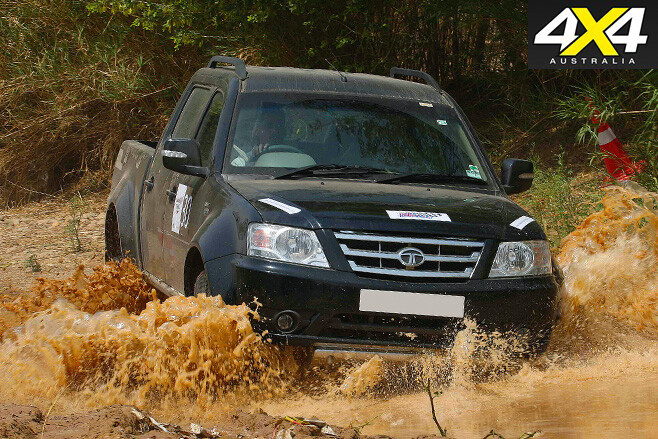
The Xenon you see here arrived in Australia in late 2013; although, an early version of the Xenon and the even earlier Tata Telcoline ute were previously sold here in small numbers.
The Xexon 4×4 comes as a single-cab with a factory tray, and single- and dual-cabs with a factory tub. All are powered by a modern 2.2-litre four-cylinder diesel with a variable geometry turbocharger, Bosch common-rail injection and Euro 5 emissions compliance.
And all are backed by a five-speed manual and part-time dual-range 4×4 system.
The engine is surprisingly quiet and refined, and it offers solid torque from low revs and reasonable pedal-to-the metal performance. Not so good is on-road steering and handling. The Xenon offers solid off-road performance aided by electronic traction control – uncommon for budget utes. The Xenon offers four-star safety, which is unique at this price.
SPECS Engine 2.2L 4cyl turbo-diesel Max power/torque 110kW/320Nm Gearbox 5M 4×4 system part-time Kerb mass 1710kg – 2050kg GVM 3100kg Tow rating 2500kg Safety rating 4-star
PRICING Single cab $22,990* Dual cab $25,990* *4×4 models only; drive away price.
For: Safety, for the price. Against: On-road dynamics.
MAHINDRA PIK-UP
The Pik-Up was first sold in Australia in 2007. It was updated in 2011 with a new engine and the addition of an Eaton self-locking rear diff.
The new engine, jointly developed by Austrian diesel specialist AVL, runs second-generation Bosch common-rail injection, meets Euro 5 emission standards, and is surprisingly refined (even if the performance is modest).
While the on-road handling isn’t anything special, the Pik-Up is very handy off-road thanks to its generous clearance and Eaton diff, which locks automatically (no electronics) in response to wheelspin. Like the Mahindra Genio, it uses a two-speed BorgWarner transfer case.
The Pik-Up’s upright and spacious cabin is more akin to the truck-like cabin of the Defender or LandCruiser 79, rather than something like the passenger-car-style cabin of a Toyota HiLux.
The Pik-Up comes with a single- or dual-cab as both a cab-chassis and with a factory tub. The Pik-Up dual-cab has a three-star ANCAP safety rating.
SPECS Engine 2.2L 4cyl turbo-diesel Max power/torque 88kW/280Nm Gearbox 5M 4×4 system part-time dual-range Kerb weight 2060kg – 2120kg GVM 3150kg Tow rating 2500kg Safety rating 3-star (dual-cab)
PRICING Single cab $23,990 – $24,990* Dual cab $26,490 – $26,990* *4×4 models only; prices are drive away.
For: Low price; proven design; big cabin. Against: Modest performance.
MAHINDRA GENIO
The Genio is smaller than Mahindra’s other 4×4 ute, the Pik-Up, which has been available in Australia since 2007.
Mahindra began assembling Jeeps under license from Willys-Overland at the end of WWII, but is now a global conglomerate employing 155,000 people in more than 100 countries. It’s also the world’s largest producer of tractors, and it owns Korean manufacturer Ssangyong, which sells its own budget ute – the Actyon – here in Australia.
The Genio arrived here in late 2013, initially only as a 4×2 single-cab. Now it’s available in 4×4 single- and dual-cabs, both with factory aluminium trays.
The Genio is powered by the same 88kW/280Nm 2.2-litre diesel as the bigger Pik-Up, an engine that was jointly developed by Austrian diesel specialist AVL. The engine is backed by a five-speed manual and a BorgWarner two-speed transfer case. Standard equipment includes ABS brakes, dual front airbags and cruise control. The Genio has not been ANCAP safety tested.
SPECS Engine 2.2L 4cyl turbo-diesel Max power/torque 88kW/280Nm Gearbox 5M 4×4 system part-time dual-range Kerb weight 1820kg – 1980kg GVM 2980kg Tow rating NA Safety rating No rating
PRICING Single cab $23,490* Dual cab $26,990* *4×4 models only; prices are drive away.
For: Low prices; long-established manufacturer. Against: No safety rating.
FOTON TUNLAND
The Beiqi Foton Motor Company is relatively new (1996) in the Chinese vehicle industry.
It makes a wide range of commercial vehicles including trucks, buses, vans, people movers, utes and even mobile cranes. Foton has joint-venture relationships with Daimler-Benz (for medium and heavy-duty trucks) and Cummins (diesel engines).
The Tunland ute is powered by a 2.8-litre, Cummins-designed, four-cylinder diesel that makes a modest 120kW and 280Nm. The engine is made under license by Foton, as are most of the other driveline components including the Getrag five-speed gearbox, Borg-Warner two-speed transfer case and Dana axles. The Tunland also sports Bosch electronics and ABS.
All of this should work in the Tunland’s favour in terms of longevity and reliability, but it also means the Tunland is priced closer to established brands such as Mitsubishi’s Triton.
The Tunland 4×4 is sold as a single-cab (with an aluminium tray) or as a dual-cab ute. Both have three-star ANCAP safety.
SPECS Engine 2.8L 4cyl turbo-diesel Max power/torque 120kW/280Nm Gearbox 5M 4×4 system part-time dual-range Kerb weight 1879kg – 1950kg GVM 2894kg – 2975kg Tow rating 2500kg Safety rating 3-star
PRICING Single cab $25,990* Dual cab $30,990* *4×4 models only; drive-away price.
For: Heritage of driveline components. Against: Only three-star safety.
SSANGYONG ACTYON UTE
The Ssangyong Motor brand only came into being in 1986, but like many of its fellow Koreans the company had its roots in the economic boom that South Korea enjoyed after the Korean War. At one stage, Ssangyong Motor’s founding company even manufactured Jeeps for the US military!
Ssangyong joined Mercedes-Benz in a joint venture in 1988 (remember the 1990s Benz-powered Ssangyong Musso wagon?). Since then, the company has been acquired by Daewoo and Chinese carmaker SAIC. From 2011 it has been owned by Indian manufacturer Mahindra.
The Ssangyong Musso Sports ute, based on the Musso wagon, appeared in Australia in 2004, while the Actyon-based replacement (also badged Sports) arrived in 2007. It too is based on a wagon, so has coil rather than leaf springs at the rear.
The Actyon ute only comes as a dual-cab, but in two spec levels with a six-speed manual or the option of a five-speed auto. It drives well, has a comfortable cabin with a decent back seat, and is surprisingly refined, but the tub is short and it needs more clearance for off-road use. No safety rating, but it does have electronic stability and traction control.
SPECS Engine 2.0L 4cyl turbo-diesel Max power/torque 114kW/360Nm Gearbox(s) 6M/5A 4×4 system part-time dual-range Kerb weight 2022kg – 2035kg GVM 2740kg Tow rating 2300kg Safety rating No rating
PRICING Dual cab $29,490* – $30,990* *4×4 models only; prices are drive away.
For: Drives well considering the price. Against: No safety rating.
NISSAN PATROL
The Patrol is one of three heavy-duty utes here, the others being the Toyota LandCruiser 79 and the Land Rover Defender. The key difference between these three heavy-duty utes and the rest of the ute market is that the heavy-duty utes are more like light trucks and don’t have the passenger-car feel of the popular mainstream utes.
Much of that comes down to the fact that the Patrol, LC79 and Defender all have live axles front and rear, while all of the other utes have independent front suspension. And while live axles are generally robust and a bonus off-road, they don’t steer and handle on-road as well as an independent set-up.
The Patrol is powered by its long-serving 3.0-litre four-cylinder diesel that musters a modest 118kW and 360Nm, which means the performance isn’t great. It’s backed by a well-proven five-speed manual and part-time dual-range 4×4 system.
The Patrol only comes as a single-cab, but is offered with either coil rear suspension with a 3150kg GVM or with more heavy-duty leaf springs that bump the GVM up to 3400kg. The Patrol is an honest workhorse, but isn’t as cheap as it should be given the age of its design and its modest performance.
SPECS Engine 3.0L 4cyl turbo-diesel Max power/torque 118kW/380Nm Gearbox 5M 4×4 system part-time dual-range Kerb weight 2014kg – 2135kg GVM 3150kg – 3400kg Tow rating 3200kg Safety rating 3-star
PRICING Single cab $52,990 – $55,990 *Does not include on-road costs.
For: Robust chassis; capable off-road. Against: Underpowered engine.
JMC VIGUS
Jiangling Motors Company (JMC) started automotive component manufacturing in the mid-1990s with a joint venture with Isuzu. JMC also has a joint venture relationship with Ford (since 1997) building (among other things) a version of the Transit van. JMC produces a range of utes, light trucks, vans, mini buses and SUVs, and is now ranked in China’s top 100 companies.
The Vigus is JMC’s latest ute, produced (apparently) with help from Ford. It arrived in Australia in mid-2015.
While it’s available in single-, extended- and dual-cab variants overseas, it only comes as dual-cab here, but you do get the choice of petrol or diesel engines – both 2.4 litre fours and both backed by a five-speed manual.
The 2.4-litre diesel claims a modest 90kW and 290Nm, while the petrol, made under license from Mitsubishi, claims 100kW and 201Nm. Equipment of the top-spec models extends to leather, 16-inch alloys, side steps and a tub liner. The Vigus hasn’t undergone ANCAP safety testing.
SPECS Engine* 2.4L 4cyl turbo-diesel Max power/torque 90kW/290Nm Gearbox 5M 4×4 system part-time dual-range Kerb weight 1880kg – 1947kg GVM 2695kg – 2770kg Tow rating NA Safety rating No rating *2.4-litre 4cyl petrol also available.
PRICING Dual cab $24,990 – $30,990* *4×4 models only; prices are drive away.
For: Low prices; petrol option. Against: No safety rating.
TOYOTA LANDCRUISER 79
The LandCruiser 79 is part of the long-running 70-Series family that includes the 76 Wagon and the 78 Troopcarrier.
The 79 is available as a single-cab in three spec levels, or a dual-cab in two spec levels. All come as a cab-chassis; although, Toyota offers a wide range of aluminium or steel trays as factory-option accessories.
At the heart of the 79 is a 4.5-litre V8 turbo-diesel, which claims 151kW and 430Nm – very modest figures given its capacity, and an indication that it’s very lightly stressed. The 79 is more a light truck than a ute and is a built as tough as they come. Aside from the Defender 130 and the Patrol, it’s in a class of its own here. And against the Defender and the Patrol, it has the huge advantage of its big V8 diesel.
The 79 is big, tough and simple, and can shoulder large loads. On the highway, the gearing from the five-speed manual is annoyingly short.
Also, the tray of the dual-cab largely overhangs the rear axle as both single- and dual-cab are built on the same wheelbase.
SPECS Engine 4.5L V8 turbo-diesel Max power/torque 151kW/430Nm Gearbox 5M 4×4 system part-time Kerb weight 2010kg – 2045kg GVM 3300kg Tow rating 3500kg Safety rating 3-star
PRICING Single cab $56,990 – $60,990 Dual cab $61,990 – $65,990 *Does not include on-road costs.
For: Tough as they come; goes anywhere. Against: Highway gearing annoyingly short.
VW AMAROK
The Amarok is the oldest of the mainstream utes here, arriving in Australia in early 2011. It comes in single- and dual-cab variants, with the choice of two very distinct 4×4 systems.
If you opt for the six-speed manual you get dual-range part-time 4×4. If, however, you opt for the eight-speed automatic, then you get single-range full-time 4×4.
Single-range 4×4 may sound like a limitation, but the low first gear and torque converter work together to well and truly overcome this.
The result is that the Amarok auto can go from freeway speeds to climbing up a gnarly 4×4 track without the driver having to touch a lever or flick a switch. It’s simply brilliant and as off-road-capable as the best of the mainstream utes, namely the Toyota HiLux and Ford Ranger.
The Amarok backs this up with class-leading on-road handling and refinement, a very spacious cabin and a big factory tub. All bar the single-cabs and the Core dual-cabs have the option of comfort rear springs, which reduce the payload by 220kg but offer a more compliant ride.
Unusually, single-cabs come with a factory tub, which can be deleted (saving $1500) if you just want a cab-chassis.
SPECS Engine* 2.0L 4cyl bi-turbo-diesel Max power/torque 132kw/400Nm/420Nm Gearbox(s) 6M/8A 4×4 system(s) part-time or full-time* Kerb weight 2035kg – 2051kg GVM 3040kg Tow rating 3000kg Safety rating 5-star (dual-cab) *see text
PRICING Single cab $35,490 – $39,990 Dual cab $41,490 – $63,990 *4×4 models only; does not include on-road costs.
For: Does everything well; brilliant 8-speed auto. Against: Limited country dealer network.

